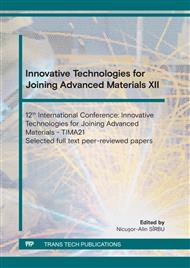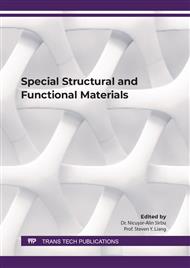[1]
European Commision, Annex for Accelerating clean energy in buildings (to the Communication from the commission to the European Parliament, the Council, the European Economic and Social Committee, the Committee of the regions and the European investment bank (2016) (https://eur-lex.europa.eu/resource.html?uri=cellar:fa6ea15b-b7b0-11e6-9e3c-01aa75ed71a1.0001.02/DOC_2&format=PDF).
DOI: 10.1163/9789004322714_cclc_2020-0164-0816
Google Scholar
[2]
X. Zhao, J. Zuo, G. Wu, and C. Huang, A bibliometric review of green building research 2000–2016, Architectural Science Review, 62(1) (2019) 74-88.
DOI: 10.1080/00038628.2018.1485548
Google Scholar
[3]
H. Kharas, The unprecedented expansion of the global middle class: An update, Global Economy and Development, (2017).
Google Scholar
[4]
L. C. M. Eberhardt, H. Birgisdottir, and M. Birkved, Potential of circular economy in sustainable buildings, IOP Conference Series: Materials Science and Engineering, 471(9) (2019) 092051.
DOI: 10.1088/1757-899x/471/9/092051
Google Scholar
[5]
Global Alliance for Buildings and Construction, 2020 Global Status Report for Buildings and Construction (2020) (https://globalabc.org/sites/default/files/inline-files/2020%20Buildings%20GSR_FULL%20REPORT.pdf).
Google Scholar
[6]
Global Alliance for Buildings and Construction, 2021 Global Status Report for Buildings and Construction (2021) (https://globalabc.org/resources/publications/2021-global-status-report-buildings-and-construction).
Google Scholar
[7]
UNEP (2019), Sand and sustainability: finding new solutions for environmental governance of global sand resources,, GRID-Geneva, United Nations Environment Programme, Geneva, available at: www.unepgrid.ch/.
Google Scholar
[8]
N. R. Kanta and M. R. Ponnada, , Performance of spent garnet sand and used foundry sand as fine aggregate in concrete, World Journal of Engineering (2021).
DOI: 10.1108/wje-10-2020-0514
Google Scholar
[9]
C. Baeră, V. Vasile, C. Matei, A. Gruin, H. Szilagyi and I.A. Perianu, Development of Green Cementitious Materials by Using the Abrasive Waterjet Garnet Wastes: Preliminary Studies, Advanced Materials Research 1164 (2021) 87-96.
DOI: 10.4028/www.scientific.net/amr.1164.87
Google Scholar
[10]
K. Bucher, T. B. Weisenberger, O. Klemm, and S. Weber, Decoding the complex internal chemical structure of garnet porphyroblasts from the Zermatt area, Western Alps, Journal of metamorphic Geology 37(9) (2019) 1151-1169.
DOI: 10.1111/jmg.12506
Google Scholar
[11]
Information on https://imaggeo.egu.eu/view/3985/.
Google Scholar
[12]
Information on https://www.sandatlas.org/garnet-sand/.
Google Scholar
[13]
H. L. Muttashar, M. A. M. Ariffin, M. N. Hussein, M. W. Hussin, and S. B Ishaq, Self-compacting geopolymer concrete with spend garnet as sand replacement, Journal of Building Engineering 15 (2018) 85-94.
DOI: 10.1016/j.jobe.2017.10.007
Google Scholar
[14]
A. Castel, T. Vidal, and R. François, Bond and cracking properties of self-consolidating concrete, Construction and Building Materials 24(7) (2010) 1222-1231.
DOI: 10.1016/j.conbuildmat.2009.12.017
Google Scholar
[15]
L. Gorrill, Global garnet market review: Mineral Price Watch 97 (2003).
Google Scholar
[16]
N. F. A. Jamaludin, K. Muthusamy,N. N. Isa, M. F. M Jaafar and N. Ghazali, Use of spent garnet in industry: A review. Materials Today: Proceedings (2021).
DOI: 10.1016/j.matpr.2021.02.210
Google Scholar
[17]
L. Ohlsson, The theory and practice of abrasive water jet cutting (Doctoral dissertation, Luleå tekniska universitet) (1995).
Google Scholar
[18]
I. A. Perianu, D. Ionescu, and V. Verbitchi, Method of measuring the abrasive-water jet diameter, for the cutting process control, Welding and Material Testing 1 (2017).
Google Scholar
[19]
W. Schumann, Gemstones of the World, Sterling Publishing Company, Inc. (2009).
Google Scholar
[20]
Information on https://gritsablare.ro/en/red-garnet-water-jet-cutting.html/.
Google Scholar
[21]
H. L. Muttashar, N. B. Ali, M. A. M. Ariffin, M. W Hussin, Microstructures and physical properties of waste garnets as a promising construction material, Case studies in construction materials 8, (2018) 87-96.
DOI: 10.1016/j.cscm.2017.12.001
Google Scholar
[22]
Muttashar, H. L., Hussin, M. W., Ariffin, M. A. M., Mirza, J., Hasanah, N., & Shettima, A. U. (2017). Mechanical properties of self-compacting geopolymer concrete containing spent garnet as replacement for fine aggregate. Jurnal Teknologi, 79(3).
DOI: 10.11113/jt.v79.9957
Google Scholar
[23]
H. L. Muttashar, M. A Mohd Ariffin, M. W Hussin, S. B. Ishaq, Realisation of enhanced self-compacting geopolymer concrete using spent garnet as sand replacement, Magazine of Concrete Research 70(11) (2018) 558-569.
DOI: 10.1680/jmacr.17.00212
Google Scholar
[24]
A. M. A Budiea, W. Z., Sek, S. N. Mokhatar, K. Muthusamy, and A. R. M. Yusoff, Structural Performance Assessment of High Strength Concrete Containing Spent Garnet under Three Point Bending Test, IOP Conference Series: Materials Science and Engineering 1144(1) (2021, May) 012018.
DOI: 10.1088/1757-899x/1144/1/012018
Google Scholar
[25]
M. A. Ab Kadir, M. I. Khiyon, A. R. M. Sam, A. B. H. Kueh, N. H. A. S. Lim, M. N. M. A. Mastor, N. Zuhan, and R. N. Mohamed, Performance of spent garnet as a sand replacement in high-strength concrete exposed to high temperature, Journal of Structural Fire Engineering 10(4) (2019).
DOI: 10.1108/jsfe-10-2018-0025
Google Scholar
[26]
N. R. Kanta, and M. R. Ponnada, Performance of spent garnet sand and used foundry sand as fine aggregate in concrete, World Journal of Engineering (2021).
DOI: 10.1108/wje-10-2020-0514
Google Scholar
[27]
N. H. A. S. Lim, N. F. N Alladin, H. Mohammadhosseini, N.F. Ariffin, and A. N. Mazlan, Properties of Mortar Incorporating Spent Garnet as Fine Aggregates Replacement, International Journal of Integrated Engineering 12(9) (2020) 96-102.
Google Scholar
[28]
K. Kunchariyakun, and Sukmak, P., Utilization of garnet residue in radiation shielding cement mortar, Construction and Building Materials 262 (2020) 120122.
DOI: 10.1016/j.conbuildmat.2020.120122
Google Scholar
[29]
G. F. Huseien, A. R. M. Sam, K. W. Shah, A. M. A. Budiea and J. Mirza, Utilizing spend garnets as sand replacement in alkali-activated mortars containing fly ash and GBFS, Construction and Building Materials 225 (2019) 132-145.
DOI: 10.1016/j.conbuildmat.2019.07.149
Google Scholar
[30]
G. Aydin, S. Kaya, and I. Karakurt, Utilization of solid-cutting waste of granite as an alternative abrasive in abrasive waterjet cutting of marble, Journal of Cleaner Production 159 (2017) 241-247.
DOI: 10.1016/j.jclepro.2017.04.173
Google Scholar
[31]
K. R. Usman, M. R., Hainin, M. K. I. M. Satar, M. N. M. Warid, A. Usman, Z. H. Al-Saffar and M. A. Bilema, A comparative assessment of the physical and microstructural properties of waste garnet generated from automated and manual blasting process, Case Studies in Construction Materials 14 (2021) e00474.
DOI: 10.1016/j.cscm.2020.e00474
Google Scholar
[32]
A. Wang, H. Liu, X. Hao, Y. Wang, X. Liu, and Z. Li, Geopolymer synthesis using garnet tailings from molybdenum mines, Minerals 9(1) (2019) 48.
DOI: 10.3390/min9010048
Google Scholar
[33]
Aletba, S. R., Hassan, N. A., Aminudin, E., Jaya, R. P., & Hussein, A. A. (2018). Marshall properties of asphalt mixture containing garnet waste. Journal of Advanced Research in Materials Science, 43(1), 22-27.
Google Scholar
[34]
Skanavi, N., & Dovydenko, T. (2018, June). The use of waterjet cutting wastes in the production of building materials. In IOP Conference Series: Materials Science and Engineering (Vol. 365, No. 3, p.032025). IOP Publishing.
DOI: 10.1088/1757-899x/365/3/032025
Google Scholar
[35]
Muttashar, H. L., Hussin, M. W., Ariffin, M. A. M., Mirza, J., Hasanah, N., & Shettima, A. U. (2017). Mechanical properties of self-compacting geopolymer concrete containing spent garnet as replacement for fine aggregate. Jurnal Teknologi, 79(3).
DOI: 10.11113/jt.v79.9957
Google Scholar
[36]
EPA U. Method 1311. Toxicity characteristic leaching procedure. US Environmental Protection Agency Washington, DC, USA; 1992. (https://www.epa.gov/hw-sw846/sw-846-test-method-1311-toxicity-characteristic-leaching-procedure).
Google Scholar
[37]
I. Balčiūnaitė, A. Kleišmantas, and E. Norkus, Chemical composition of rare garnets, their colours and gemmological characteristics, chemija, 26(1) (2016).
Google Scholar
[38]
X. D. Li, Y. M. Zhang, C. S. Poon, and I. M. C. Lo, Study of zinc in cementitious material stabilised/solidified wastes by sequential chemical extraction and microstructural analysis, Chemical Speciation & Bioavailability 13(1) (2001) 1-7.
DOI: 10.3184/095422901782775471
Google Scholar
[39]
D. Ionescu, S. I. Serbanescu, I. A. Perianu, Patent No. 1. 129363 of 2014, Procedure for obtaining a mortar-type construction material from abrasive material waste, Oficiul de Stat pentru Mărci și Invenții, București, România BOPI 12 (2016).
Google Scholar



